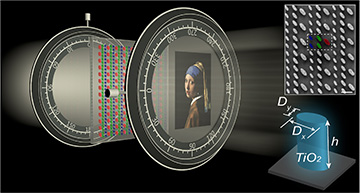
A team of researchers in China and the United States have created a surface dotted with millions of elliptical, 600-nm-tall pillars that reportedly can reshape incident white light into a highly photorealistic image. They tested their system by creating a tiny rendering of Vermeer’s famous painting Girl with a Pearl Earring. [Image: T. Xu/Nanjing University]
Researchers from China and the United States have developed a dielectric metasurface—specifically, a glass slide dotted with millions of elliptical-cross-section “nanopillars” of titanium dioxide (TiO2)—that allows both the color and intensity of incident light to be precisely tuned at the same time. The result is a surface that reportedly can transform an incident beam of white light into a full-color photorealistic “nanopainting” (Optica, doi: 10.1364/OPTICA.403092).
The metasurface enabled the team to create a square-millimeter replica of Jan Vermeer’s celebrated painting Girl with a Pearl Earring that captures much of the original oil’s delicate play of light and shadow, or chiaroscuro. Beyond sub-postage-stamp-sized renderings of art masterworks, the researchers see prospects for the new metasurface in applications such as optical communications and anti-counterfeiting protection for currency.
Refining structural color
The team’s report offers a particularly sophisticated example of the creation of structural color—brilliant hues that come not from dyes or paint, but via the interaction of light with subwavelength-scale nanostructures. In recent years, inspired by natural examples such as the morpho butterfly’s wing and the peacock’s tail, scientists have played with a variety of approaches to creating similar rich colors using engineered metasurfaces.
Early efforts along these lines focused on plasmonic metasurfaces dotted with subwavelength metallic features of various dimensions and spacing. The metallic nanostructures selectively concentrate and amplify specific wavelengths of light, and can thereby generate brilliant structural colors from incident white light. More recently, researchers have become interested in nonmetallic, dielectric metasurfaces, which use a different mechanism—so-called Mie resonances—to do the same thing, but without the substantial optical losses that have plagued plasmonic approaches (see “Meta-Optics with Mie Resonances,” OPN, January 2017).
Whether plasmonic or dielectric, however, most metasurfaces run into a stumbling block with respect to engineering “photorealistic” structural color. While surfaces have been designed that can create bright, highly saturated colors across the full visible spectrum, it’s been hard to smoothly control the brightness of those colors across that broad spectral range.
Tuning wavelength and polarization
The research team behind the new work—which included scientists from Nanjing University and the Huazhong University of Science and Technology, China, and the National Institute of Standards and Technology (NIST) and the University of Maryland, USA—wanted to find a structural-color system that allowed for smooth control of both color and brightness. To get there, they picked apart the two components of the problem.
Specifically, the team reasoned that fashioning specific structural colors from a metasurface depended primarily on the dimensions and spacing of the nanostructures decorating the surface, which govern their resonances with specific wavelengths in the incident light. Brightness, meanwhile, might be controlled, on a pixel-by-pixel basis, by tweaking another characteristic of the nanostructures: their orientation—which, in turn, could reorient the polarization of incident light. The polarization direction thus would offer a degree of freedom that could be used to control the intensity of the transmitted light.
Slides and nanopillars
In the system, vertically polarized white light is shone through the metasurface. The differing sizes of the nanopillars on the metasurface result in different structural colors, while their varying orientation rotates the polarization of the incident light to different degrees. When the transmitted light is passed through a polarization analyzer, the result is a photorealistic image capturing both the calculated color and its relative brightness, and thus reproducing the original’s play of light and shadow, or chiaroscuro. Scale bar on metasurface photomicrograph (upper right) is 500 nm. [Image: T. Xu/Nanjing University] [Enlarge image]
As a material system for realizing this idea of simultaneous color and brightness control, the team settled on a glass slide, decorated with millions of tiny TiO2 pillars. Each pillar was 600 nm tall, and had an elliptical cross section, the dimensions of which depended on the target color—250×50 nm for blue, 320×80 nm for green, and 440×170 nm for red. The orientation of the elliptical cross-section of each nanopillar was also varied, to tune its impact on the polarization of incident white light on the surface.
This approach to creating the metasurface allows both color and brightness to be tuned at the same time when the surface is designed. When a vertically polarized incident white beam strikes the back of the metasurface, size-dependent Mie resonances with the nanopillars create structural color at a particular wavelength for each nanopillar.
The orientation of the elliptical nanopillar with respect to the polarized light, meanwhile, allows it to act, according to the authors, as a narrowband half-wave plate, rotating the light polarization for that specific wavelength to a controlled degree. A polarization analyzer at the end of the chain permits a certain amount of light at each wavelength to be transmitted, depending on the degree to which its polarization has been rotated—effectively allowing brightness of each color to be controlled through the orientation of the tiny elliptical nanopillars.
Tough test
With this concept for controlling both color and brightness in hand, the researchers set themselves a tough test of the system: a replica of Vermeer’s famous canvas, celebrated for its subtle chiaroscuro. They began by creating a digital copy of the painting, roughly a millimeter in length. They then calculated a unit cell of five nanopillars—one red, two green and two blue—for each pixel of the digital image, with the orientation of the nanopillars tuned to reproduce the relative brightness of that primary color in that pixel.

The final experimental color image from the metasurface (scale bar: 50 µm) captures much of the texture of Vermeer’s original. [Image: T. Xu/Nanjing University]
Finally, the team laid down the calculated array of TiO2 nanopillars for the entire metasurface on a glass slide. To do so, they first coated the slide with a clear polymer layer a few hundred nanometers thick, and used electron beam lithography to bore out holes of the right cross-sectional dimensions and orientations in the polymer layer. Then they used atomic layer deposition to build up the TiO2 nanopillars in the holes, and dry-etched away the polymer.
The result was a glass-slide base decorated with a field of millions of nanopillars at varying sizes and orientations. When polarized white light was shone through the metasurface and then through the analyzer, the result was a strikingly clear and subtle rendering of the texture of the Vermeer oil painting—albeit one only a square millimeter or so in size.
Art and commerce
In a press release accompanying the work, NIST investigator Amit Agrawal says that the work “quite elegantly bridges the fields of art and nanotechnology.” But the researchers see applications beyond the world of art. For example, they point out that their “nanopainting” technique could be used to place small but very difficult to counterfeit features on paper money. And they believe that the surfaces’ ability to tune color and brightness simultaneously could find use in optical communications as well.

